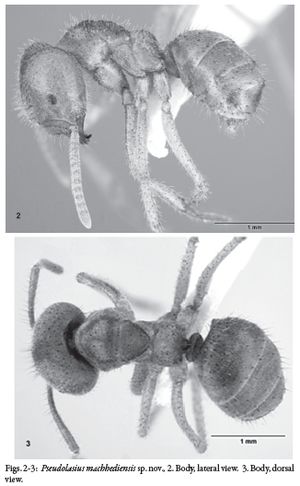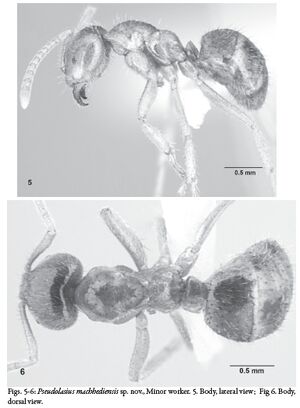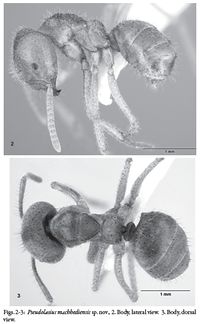Pseudolasius machhediensis
| Pseudolasius machhediensis | |
|---|---|

| |
| Scientific classification | |
| Kingdom: | Animalia |
| Phylum: | Arthropoda |
| Class: | Insecta |
| Order: | Hymenoptera |
| Family: | Formicidae |
| Subfamily: | Formicinae |
| Tribe: | Lasiini |
| Genus: | Pseudolasius |
| Species: | P. machhediensis |
| Binomial name | |
| Pseudolasius machhediensis Bharti, Gul & Sharma, 2012 | |
The species has been collected from North-West Himalaya, in Jammu and Kashmir and Himachal Pradesh. The species inhabits moderately wet and lighted forested areas with scarce undergrowth and in all the cases specimens were collected under stones by hand picking.
Identification
Bharti et al. (2012) - Based on major workers, the species is significantly different from all other reports of this genus. Pseudolasius machhediensis somewhat resembles the Chinese Pseudolasius bidenticlypeus but can be easily distinguished from the latter. In Pseudolasius machhediensis the 4th tooth is larger than the 5th and 6th teeth and the clypeus is smooth without any denticle, whereas in Pseudolasius bidenticlypeus the 4th tooth is smaller and the clypeus is with one blunt denticle at each side. It is different from Pseudolasius familiaris, the only species reported from India and can be easily separated from it, as in Pseudolasius familiaris the teeth are five in number with 4th and 5th combined, but in Pseudolasius machhediensis, the teeth are six in number with the 5th and 6th combined, the head is weakly emarginate and the antennae are much longer.
- Mandibles armed with 5 teeth, the basal two combined; antennae somewhat short . . . . . Pseudolasius familiaris
- Mandibles armed with 6 teeth, the basal two combined; antennae long, distinctly surpassing the occipital margin . . . . . Pseudolasius machhediensis
Keys including this Species
Distribution
Latitudinal Distribution Pattern
Latitudinal Range: 32.844098° to 32.074°.
| North Temperate |
North Subtropical |
Tropical | South Subtropical |
South Temperate |
- Source: AntMaps
Distribution based on Regional Taxon Lists
Oriental Region: India (type locality).
Distribution based on AntMaps
Distribution based on AntWeb specimens
Check data from AntWeb
Countries Occupied
| Number of countries occupied by this species based on AntWiki Regional Taxon Lists. In general, fewer countries occupied indicates a narrower range, while more countries indicates a more widespread species. |

|
Estimated Abundance
| Relative abundance based on number of AntMaps records per species (this species within the purple bar). Fewer records (to the left) indicates a less abundant/encountered species while more records (to the right) indicates more abundant/encountered species. |

|
Biology
Castes
Worker
   
| |
| . | |
Nomenclature
The following information is derived from Barry Bolton's Online Catalogue of the Ants of the World.
- machhediensis. Pseudolasius machhediensis Bharti, Gul & Sharma, 2012: 806, figs. 1-6 (s.w.) INDIA.
Unless otherwise noted the text for the remainder of this section is reported from the publication that includes the original description.
Description
Worker
Major HL 1.25-1.36(1.36); HW 1.15-1.40(1.40); SL 1.13-1.25(1.20). (n=5)
Head: Head subquadrate [CI= 92-103(103)]; occipital margin weakly emarginate; occipital corners round; lateral sides subparallel, narrowing towards the anterior margin; anterior clypeal margin broadly round, somewhat transverse in the median portion; eyes small, round, situated in front of the middle of sides of head; mandibles triangular, the masticatory margin with 6 prominent teeth, the 3rd apical tooth smaller than the 2nd and 4th, the 4th tooth larger than the 5th and 6th teeth; frontal area small, triangular; frontal carinae short, parallel; antennae slender,12 segmented, scape fairly long, distinctly surpassing the occipital margin [SI= 85-100(85)], last segment of the funiculus slightly longer than the two preceding segments taken together.
Mesosoma and Petiole: Mesosoma with weakly convex promesonotal dorsum, broadest across humeral angles; pronotum convex with the sides round, mesonotum and metanotum with the sides somewhat flat; promesonotal and mesometanotal sutures quite distinct; petiolar node with the sides more or less round, apex thin and more or less emarginate; legs stout and fairly long.
Gaster: Gaster long, oval, narrowed infront and behind, pointed at apex.
Sculpture: Head roughly smooth except for the microreticulated sculpture visible at the higher magnification; mandibles distinctly rugulose more so towards the apex; punctures and tubercles scattered all over the body; clypeus smooth and much more shiny; sculpture of mesosoma as in head; abdomen smooth and somewhat shiny.
Pilosity: Body clothed with silky yellow pubescent hairs and longer and shorter outstanding hairs; pubescence is more on head and mesosoma.
Color: The species is pale yellow in color but in some specimens the head is darker and the abdomen brown; the teeth and eyes are black and the legs yellow.
Minor HL 0.8-1.0(0.84); HW 0.72-1.02(0.77); SL 0.72-1.1(0.8). (n=28)
Head: Head roughly square [CI= 89-102(91)]; occipital margin straight to feebly excised in some specimens; occipital corners round; lateral sides more or less parallel; anterior clypeal margin broadly rounded; eyes small, round, situated in front of the middle of sides of head; mandibles triangular, the masticatory margin with 6 prominent teeth, the 3rd apical tooth smaller than the 2nd and 4th, the 4th tooth larger than the 5th and 6th teeth; frontal area small, triangular; frontal carinae short, nearly parallel; antennae slender, 12 segmented, scape fairly long, distinctly surpassing the occipital margin [SI= 100-107(104)], last segment of the funiculus slightly longer than the two preceding segments taken together.
Mesosoma and Petiole: Mesosoma with weakly convex promesonotal dorsum, broadest across humeral angles; pronotum convex with the sides round, mesonotum and metanotum with the sides somewhat flat; promesonotal and mesometanotal sutures quite distinct; petiolar node with the sides more or less straight, apex thin and emarginate; legs stout and fairly long.
Gaster: Gaster long, oval, narrowed in front and behind, pointed at apex.
Sculpture: The sculpture is same as that of the major workers. The minors are more shining all over; the whole body is much smoother than the major workers; mandibles distinctly rugulose all over; punctures and tubercles scattered all over the body; clypeus smooth and shiny.
Pilosity: Longer and shorter outstanding hairs scattered all over the body; the minor workers are quite deficient of pubescence, the pubescence is not as much as in case of major workers and is denser on the head.
Color: The color varies from light yellow to pale yellow with a darker abdomen; the teeth and eyes are black.
Type Material
Holotype, major worker: India, Jammu & Kashmir, Machhedi, 32.72364N, 75.669464E, 2130m above msl, 15.xi.2008. Paratypes: 2 major workers, 7 minor workers, same data as holotype; 2 major workers, 27 minor workers, India, Himachal Pradesh, Gangradi, 32.844098N, 77.151283E, 1600m above msl, 05.xii.2010; 2 minor workers, India, Himachal Pradesh, Kulu, Patlikul town, 32.074N, 77.088E, 1200m above msl, 29.v.1999; hand picking (coll. Irfan Gul & Himender Bharti).
Etymology
The species is named after the type locality, Machhedi.
